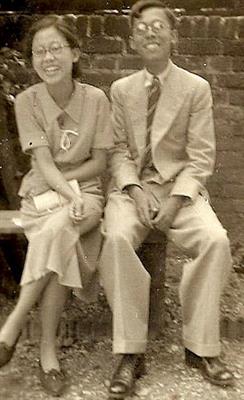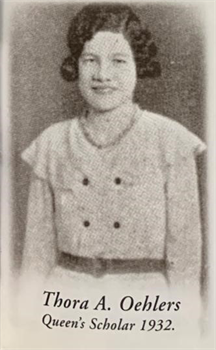Clarice Chee

This article is part of the RI at 200: History Series, and is part of a trilogy about the place of girls in RI. Future pieces will focus on the place of girls’ in RI’s pre-university classes, as well as the development of co-education in the post-war period.
Raffles Institution is primarily known as one of the premier boys’ schools in Singapore. Even so, RI historically also played a part in educating girls. While the education of girls was more an exception than a norm, RI provided a space for one of the earliest girls’ schools to develop and offered girls the rare opportunity to further their education.
Girls’ education in colonial Singapore was pioneered by female western missionaries, whose goal revolved around religious evangelism and shaping their (typically less well-off) students into competent homemakers. Similarly, the education of girls in Raffles Institution (then known as the Singapore Institution) was initiated by a Ladies’ Committee, who in 1844 established a ‘Female Boarding School or Asylum’ in the institution.
Religious and moral instruction formed the impetus for the founding of the girls’ school. According to Reverend D. D. Chelliah, “The object in establishing the school was to shelter the girls from the many temptations to which they were exposed, and the provision of some form of education was only secondary”. Evincing a Victorian ethos of charity and rescue, the Governor of the Straits Settlements described the target demographic of the Girls’ School as the “children of poor Protestant parents”.
Although it used the same premises as the Singapore Institution, the Girls’ School was practically structured as a separate school. In 1846, the Girls’ School was fenced off, and a wall was erected in 1847 to divide the Girls’ and Boys’ playing areas (a structure which stood until at least 1927!). As the boys’ school expanded, the Girls’ School (which became known as Raffles Girls’ School by 1890) constantly moved from one building to another on the Bras Basah campus. It eventually moved out in 1928 to a campus on Queen Street, due to the especially bad state of congestion in RI in 1927. Thus, the primary and secondary education of girls in RI came to an end.

Maggie Tan with her brother, Tan Thoon Lip, 1930s
Taken from the Rafflesian Times, 2013 edition
At the same time, however, RI began to include girls in its post-secondary classes. In 1924, the colonial government opened the Queen’s Scholarship – the most prestigious academic prize in the Straits Settlements – to girls. Although the exact reason for this reform was unclear, Dr Lim Boon Keng and Song Ong Siang helped to revive the scholarship in 1923 (after it was shut down in 1911), and were both vocal proponents of girls’ education. In response, RI began admitting girls into the Queen’s Scholarship Class - a specialised class for talented students aiming for the Queen’s Scholarship. In addition, RI also admitted students from other schools, which like RGS, did not have a similar programme to prepare Queen’s Scholarship aspirants.

Emily Sadka, Editor of The Rafflesian (1935-1938) and Queen’s Scholar (1938)
Taken from The Rafflesian (Vol 14 No. 1, 1938)
In the 1930s, a number of female Queen’s Scholars emerged from the RI class: Maggie Tan, Thora Oehlers and Emily Sadka. Oehlers received high praise in The Rafflesian for her academic success. The editors congratulated her on “her brilliant results”: she had received Honours and distinctions in English, Religious Knowledge, Geography, and Latin, “the highest number of distinctions, we believe, in Malaya.” Similarly, a photograph of Sadka appeared prominently in the 1938 edition of The Rafflesian – a decision which invited commentary from the editors. “The photograph of a girl as frontispiece to the magazine of a Boys’ School may require some explanation,” they wrote. “To the uninitiated we may say that Miss Sadka belonged to that select band, the Queen’s Scholarship Class, which usually includes a few girl students.” Although these girls were exceptional academically, they were also exceptional in their position in the school, given that RI was still primarily identified as a boys’ school.

“Letters to Singapore” written by Emily Sadka
The Rafflesian (Vol 11 No. 3, 1935)
Outside the classroom, the girls contributed to various aspects of school life. Sadka served as an editor of The Rafflesian from 1935 to 1938. In the 1938 edition, her fellow editors noted that “in this editorial work Miss Sadka has taken a full share, and she has also brightened our pages by frequent and witty contributions.” Among her contributions was a piece titled “Letters to Singapore”, where she talked about the ridiculous assumptions that foreign pen-pals had made about Singapore.
Despite that, the girls were also limited in visibility. There were no female leaders in the different clubs or Houses, nor were there female prefects. During the 1920s, there were at least two occasions where the Literary and Drama Club put on productions involving female characters which were played by male students. A number of articles written by male students in The Rafflesian in 1920s made clear the disdain experienced by women, variously portraying women as either battle-axe suffragettes, or as frivolous and manipulative.

Thora A. Oehlers, Queen’s Scholar 1932
Taken from The Eagle Breeds A Gryphon by E. Wijeysingha
Given the constraints of gender, class played a role in the academic success of female Queen’s Scholars. All came from relatively well-off families, whose relatives had also gone to Raffles Institution. Maggie Tan, the first female Queen’s Scholar, was a descendant of the businessman and philanthropist Tan Tock Seng. Her brother, Tan Thoon Lip, was also a Queen’s Scholar. Thora Oehlers came from a leading local Eurasian family; her father owned the Clarke Livery Stables and (surprisingly) also won 3 sweepstakes. She was also the younger sister of George Oehlers (a 1925 Queen’s Scholar). Emily Sadka was the grandniece of the Chief Rabbi of Baghdad, and her cousin was David Marshall (the future Chief Minister of Singapore, and fellow RI alumnus).
For the vast majority of women, gender hindered their prospects. Tan Sock Kern, a RGS alumna, recalled in a 1993 Oral History Interview that “there were very few women that were graduates in those days”. Her traditional father disapproved of her pursuing higher education in Raffles College because it was a mixed college, and “it’s not the thing for boys and girls to mix.” Consequently, girls who received a secondary education were likelier to start work than to pursue further education.
Against this backdrop, the stories of RI’s pioneering female Queen’s Scholars are all the more remarkable. Today, the place of Year 5-6 girls in RI is far less tenuous, and female students routinely receive the President’s Scholarship (the successor to the Queen’s Scholarship). Hopefully, RI will continue to nurture female talent who will serve as trailblazers and role models for all RI students.
Clarice is a Year 5 Humanities Programme student in RI. Other than exploring her interest in women’s history, she spends her time despairing at her inability to conjugate French verbs.
___
1. Arora, M. (Ed.). (2007). Small Steps, Giant Leaps: A History of AWARE and the Women’s Movement in Singapore. Singapore: AWARE.
2. Arthur, T.G. “Lluvia D’oro.” The Rafflesian, Vol 2 No. 3, December 1926.
3. Bolter, M., & Kathiravalu, T. (Eds.). “Editorial”. The Rafflesian, Vol VII No. 1, June 1931.
4. “Rise and rough times of RGS”. New Nation. 17 March 1980.
5. Chin, A., & Singam, C. (2004). Singapore Women Re-Presented. Singapore: Landmark Books.
6. Chow, Y. H. (2011). “Singapore Chinese Girls’ School”. Singapore Infopedia, National Library of Singapore. Available online at: https://eresources.nlb.gov.sg/infopedia/articles/SIP_1157_2011-03-24.html
7. Chua, J. C. H. (1996). KIANG Ai Kim (Prof): Reel/Disc 4 of 17. 1 April. National Archives of Singapore. Available online at: https://www.nas.gov.sg/archivesonline/oral_history_interviews/record-details/45dd8da7-115e-11e3-83d5-0050568939ad
8. Davis, V. J. (2017). “Disease, Bread, Efficiency: Rhetorics of Victorian Education Reform”. LSU Doctoral Dissertations. Available online at: https://digitalcommons.lsu.edu/cgi/viewcontent.cgi?article=5458&context=gradschool_dissertations
9. “One’s Sister.” 1929. The Rafflesian, Vol 5 No. 3, December. http://digital.vthere.sg/bookcase/xhzra/
10. “Father of Two Queen’s Scholars” , The Straits Times, 30 January 1937.
11. “The Oehlers Celebrate 50 Years of Bliss.” The Straits Times, 30 March 1952.
12. “A History of Raffles Institution: The School Properties”. The Rafflesian, Vol 3 No. 3, December 1927.
13. Lee, E.N. and Lewis, P.R. “School Notes”. The Rafflesian, Vol 6 No 1, April 1930.
14. Lim, C. E. (1981, April 8). LAI Kai Joo: Reel/Disc 2 of 5. National Archives of Singapore. Available online at: https://www.nas.gov.sg/archivesonline/oral_history_interviews/record-details/25d1182d-115f-11e3-83d5-0050568939ad
15. Lim, I. L. P. (2008). “Maria Dyer”. Singapore Infopedia, National Library of Singapore. Available online at: https://eresources.nlb.gov.sg/infopedia/articles/SIP_1343_2008-12-10.html
16. “Literary and Dramatic Society: Scenes from Shakespeare”. The Rafflesian, Vol 1 No. 3, July 1925.
17. “Matrimony (For and Against)”. The Rafflesian, Vol 1 No. 1, November 1924.
18. Raffles Archives and Museum. (2016). “History of RGS”. RAMpage. Available online at: https://rafflesrampage.wordpress.com/history-of-rgs/
19. Raffles Girls’ School. (n.d.). “Historical Milestones”. Retrieved 5 June 2021, from https://www.rgs.edu.sg/about-us/historical-milestones
20. Sadka, E. “Letters to Singapore.” The Rafflesian, Vol 11 No. 3, November 1935.
21. Sadka, E., Menon, N. B., & Sadka, F. S. (Eds.).. “School Notes”. The Rafflesian, Vol 19 No. 1, March 1938.
22. Singapore Women’s Hall of Fame. (2021). “St. Mathilde Raclot”. 11 March. Available online at: https://www.swhf.sg/profiles/st-mathilde-raclot/
23. Sutherland, D. (2010). “Queen’s Scholarship”. Singapore Infopedia, National Library of Singapore. Available online at: https://eresources.nlb.gov.sg/infopedia/articles/SIP_1706_2010-10-10.html
24. Umnuey. ”Chop Suey”. The Rafflesian, Vol 1 No. 3, July 1925.
25. Wijeysingha, E. (2004). The Eagle Breeds A Gryphon (3rd ed.). Singapore: Raffles Institution.
26. W.S.K. (1926, July). “Modern Chivalry”. The Rafflesian, Vol 2 No. 2, July 1926.
27. Yeo, G. L. (1993, September 20). TAN Sock Kern. National Archives of Singapore. Available online at: https://www.nas.gov.sg/archivesonline/oral_history_interviews/interview/001427